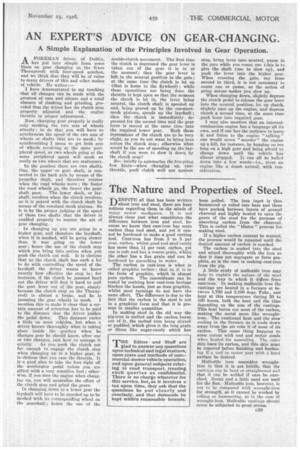AN EXPERT'S ADVICE ON GEAR-CHANGING.
Page 61

If you've noticed an error in this article please click here to report it so we can fix it.
A Simple Explanation of the Principles Involved in Gear Operation.
AFOREMAN driver, of Dublin, has put into simple form some
hints on gear changing on the 0-ton Thornycroft with four-speed gearbox, and we think that they will be of value to many drivers of this and other makes of vehicle. He writes:— I have demonstrated in my teaching that all changes can be made with the greatest of ease and silence and a total absence of clashing and grinding, provided that the driver has the clutch stop properly adjusted and the engine throttle in proper adjustment.
Now, changing gear properly is really only meshing the two sets of wheels silently ; to do that you will have to synchronize the speed of the two sets of wheels or shafts that are to mesh ; by synchronizing I mean to get both sets of wheels revolving at the same peripheral speed, as two wheels going at the same peripheral, speed will mesh as easily as two wheels that are stationary. In the gearbox there are two shafts. One, the upper or gear shaft, is con nected to the back axle by means of the propeller shaft, and therefore rotates when the road wheels move ; the faster the road wheels go, the faster the gear shaft goes. The lower shaft, or lay shaft, revolves when the clutch revolves, as it is geared with the clutch shaft by means of the constant mesh pinions. So it is by the proper judging of the speed of these two shafts that the driver is enabled properly to master the art of gear changing.
In changing up you are going to a higher gear, and therefore the layshaft, when it is meshed, will be going slower than it was going on the lower gear ; hence the use of the clutch stop which you bring into action when you push the clutch out well. It is obvious that as the clutch shaft has such a lot to do with controlling the speed of the
layshaft the driver wants to know• exactly how effective the stop is •' for
instance, if the clutch be jammed hard out the driver will find it hard to pull the gear lever out of the gear, simply because the clutch stop on the Thornycroft is almost a brake, and he is jamming the gear wheels in mesh. I mention this to make it clear that a certain amount of attention has to be paid to the distance that the driver pushes the pedal down. This distance varies a little on most vehicles, but when a
driver knows thoroughly what is taking place inside the gearbox when he changes gear he should know, after one or two changes, just how to manage it quietly. As you push the clutch out far enough to engage the clutch stop when changing up to a higher gear, it is obvious that you ease the throttle. It is a good plan to take the foot right off the accelerator pedal unless you are gifted with a very sensitive foot ; otherwise, if you race the engine when changing up, you will neutralize the effect of the clutch stop and grind the gears.
In changing down to a lower gear the layshaft will have to be speeded up to be meshed with its corresponding wheel on the gearshaft; hence the use of the
double-clutch movement. The first time the clutch is depressed the gear lever is taken out of the gear it is in at the moment ; then the gear lever is left in the neutral position in the gate ; at the same time the clutch is let up (that is home in the flywheel) ; while these operations are being done the throttle is kept open so that the moment the clutch is let in, the lever being neutral, the clutch shaft is speeded up and, being geared up by the constantmesh pinions, speeds up the layshaft ; then the clutch is immediately depressed for the second time and the gear lever is moved at the same time into the required lower gear. Both these depressions of the clutch are to be very slight, as you do not want to bring into action the clutch stop ; otherwise what would be the use of speeding up the layshaft if you were to slow it down by the clutch stop?
So--briefly to summarize the foregoing few hints—when changing up, ease throttle, push clutch well out against
stop, bring lever into neutral, pause in the gate while you count one (this is to give the shaft time to slow up), and push the lever into the higher gear. When crossing the gate, say from second to third, it is not necessary to count one or pause, as the action of going across makes you slow up.
When changing down, slightly depress the clutch pedal to release the gear lever into the neutral position, let up clutch, slightly race up the engine, and depress clutch a second time, at the same time push lever into required gear.
I may also mention that an internalcombustion engine has a language all its own, and if one has the patience to learn it and listen to the engine " talking " one would never " murder " the engine up a bill, for instance, by hanging on too long on a high gear and being afraid to change down until the vehicle has almost stopped. It can all be boiled down into a few words—i.e., treat an engine like a dumb animal, with consideration.












































































































